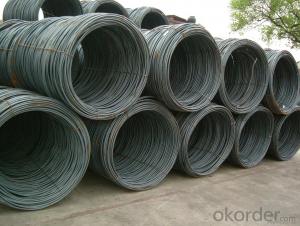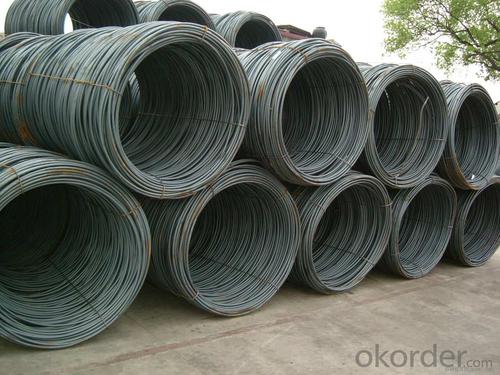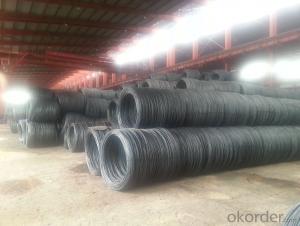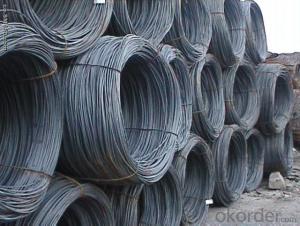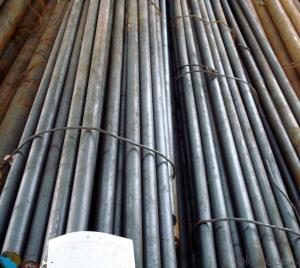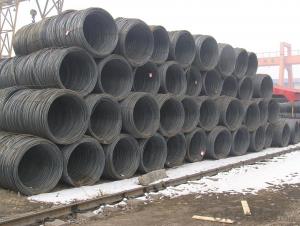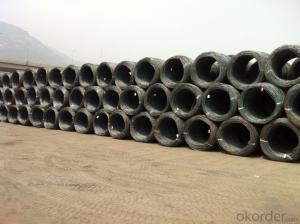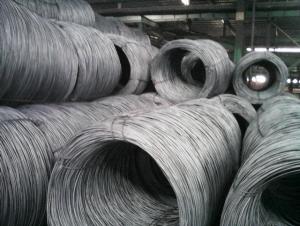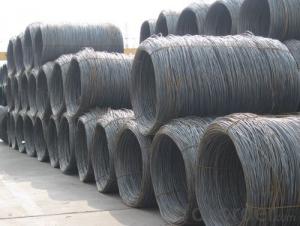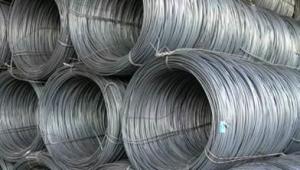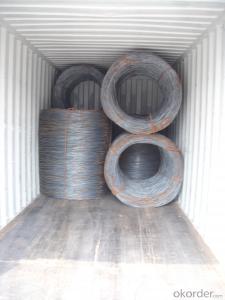Hot Rolled Round Rod Coil
- Loading Port:
- China Main Port
- Payment Terms:
- TT OR LC
- Min Order Qty:
- -
- Supply Capability:
- -
OKorder Service Pledge
OKorder Financial Service
You Might Also Like
Specifications of Hot Rolled Wire Rod:
Steel Grade: Q195/235, SAE1006-1018B Standard: ASTM, GB
Diameter: 5.5mm, 6.5mm, 7mm,8mm,9mm,10mm,12mm,14mm
Type: in coil, coil weight around 2MT Alloy or Not: Alloy
Technique: Hot Rolled Place of Origin: China Mainland
Surface: round, no twisted, light and smooth
Chemical Composition: (Please kindly find our chemistry of our material based on Q195、Q235A and Q235B as below for your information)
| Trademark | Rank | Chemical composition (quality score) % | ||||
| C | Si | Mn | S | P | ||
| ≤ | ≤ | ≤ | ||||
| Q195 | 0.06-0.12 | 0.30 | 0.25 | 0.050 | 0.045 | |
| Q235 | A | 0.14-0.22 | 0.30 | 0.30-0.65 | 0.050 | 0.045 |
| Q235 | B | 0.12-0.20 | 0.30 | 0.30-0.70 | 0.045 | 0.045 |
Usage and Applications of Hot Rolled Wire Rod:
After hotrolled the products shaped into coil and delivery as finished product, including round, square, rectangular, hexagonal and so on. Since most of the products are round, it is generally called wire rod. Carbon steel wire rod is widely used in construction and manufacturing. Carbon steel wire rod is mainly used for reinforcement of reinforced concrete and welded structure or reprocessed (roberts , nail, etc.) materials, especially used to produce wire drawing, welding electrode, nails, spring, electronic, precise machinery parts and so on.
Packaging & Delivery of Hot Rolled Wire Rod:
Packaging Detail: products are packed in coil, each coil weight around 2 MT, and then shipped by container or bulk vessel
Delivery Detail: within 45 days after received deposit or LC.
Label: to be specified by customer, generally, each bundle has 1-2 labels
Trade terms: FOB, CFR, CIF
- Q: What are the different types of wire rods for reinforcement made from steel wire rod?
- Wire rods for reinforcement, which are made from steel, come in several different types. These include: 1. Mild Steel Wire Rods: The most commonly used type, these wire rods are made from low carbon steel. They offer good strength and durability, making them suitable for various applications. 2. High Tensile Steel Wire Rods: Specifically designed to provide greater strength and resistance to tension, these wire rods are made from high carbon steel. They are commonly used in construction projects or the manufacturing of heavy machinery. 3. Stainless Steel Wire Rods: Made from corrosion-resistant stainless steel, these wire rods are commonly used in environments prone to corrosion, like coastal areas or chemical processing plants. 4. Galvanized Steel Wire Rods: To protect against corrosion, these wire rods are coated with a layer of zinc. They are often used in outdoor applications or areas with high moisture levels. 5. Copper-Clad Steel Wire Rods: These wire rods have a steel core with a layer of copper cladding. They combine the strength and durability of steel with the excellent electrical conductivity of copper, making them ideal for electrical wiring or grounding systems. In conclusion, the different types of wire rods for reinforcement made from steel offer a range of properties and characteristics to suit various applications and environments.
- Q: How is steel wire rod used in the manufacturing of wire mesh for concrete reinforcement?
- Steel wire rod is used in the manufacturing of wire mesh for concrete reinforcement by being formed into a grid-like pattern. This wire mesh is then embedded within the concrete to provide added strength and stability, preventing cracking and ensuring durability. The steel wire rod acts as a reinforcement, distributing the load and increasing the overall structural integrity of the concrete.
- Q: What are the main trends in the steel wire rod industry?
- The future of the steel wire rod industry is being shaped by several key trends. One of the main trends is the rising demand for steel wire rods in different industries, such as construction, automotive, and manufacturing. Construction projects worldwide are driving this demand, while the automotive industry relies heavily on steel wire rods for various components. As these industries continue to grow, the demand for steel wire rods is expected to increase. Another significant trend is the move towards higher quality and more advanced steel wire rods. Manufacturers are now seeking steel wire rods that offer superior strength, durability, and corrosion resistance, aligning with the growing focus on sustainability and energy efficiency. To meet these demands, innovative steel wire rod grades and processes have been developed, delivering improved performance characteristics. Advanced technologies like microalloying and controlled cooling have also played a role in producing high-quality steel wire rods with better mechanical properties. Furthermore, the steel wire rod industry is experiencing a rise in the adoption of automation and digitization. Manufacturers are embracing advanced manufacturing technologies such as robotics and artificial intelligence to enhance productivity, reduce costs, and improve product quality. Automation enables efficient production processes, while digitization allows for real-time monitoring and control of operations. These technological advancements are revolutionizing the steel wire rod industry, making it more efficient, flexible, and responsive to market demands. Sustainability is also a critical trend in the steel wire rod industry. Environmental concerns and regulatory requirements have prompted manufacturers to prioritize eco-friendly manufacturing processes and products. Energy consumption reduction, emissions minimization, and resource optimization are among the measures being implemented. This involves the adoption of energy-efficient technologies, recycling initiatives, and the development of eco-friendly steel wire rod grades. Sustainability has become a driving force behind innovation and competitiveness in the industry. To summarize, the steel wire rod industry is being shaped by trends such as increasing demand, a focus on higher quality and advanced products, the embrace of automation and digitization, and a commitment to sustainability. These trends are propelling innovation and creating new opportunities for manufacturers in the industry.
- Q: How is steel wire rod used in the production of wire displays?
- Steel wire rod is used as the primary raw material in the production of wire displays. It is shaped, cut, and bent into various forms to create the frames, shelves, hooks, and other components of wire displays. The high strength and durability of steel wire rod make it ideal for supporting and displaying products in retail stores, exhibitions, and other promotional events.
- Q: How is steel wire rod used in the manufacturing of wire forms for automotive components?
- Automotive components rely heavily on steel wire rod, an essential element in the production of wire forms. These wire forms are intricate designs created from metal wire and serve vital functions in various automotive applications such as springs, clips, brackets, and fasteners. The procedure begins with steel wire rods, typically composed of carbon or alloy steel. These rods act as the raw material for wire drawing, the primary technique employed to manufacture wire forms. Wire drawing involves pulling the steel wire rod through a series of dies to reduce its diameter and increase its length. This process enhances the wire's tensile strength and surface finish, making it suitable for automotive purposes. Once the desired wire diameter is achieved through wire drawing, it is then fed into specialized machinery to form different wire forms. This machinery comprises automated CNC (Computer Numerical Control) machines capable of bending, shaping, and cutting the wire precisely to meet specifications. By utilizing various tools and dies, these machines shape the wire to the desired form, ensuring accuracy and consistency. Wire forms produced from steel wire rod offer several advantages for automotive components. Firstly, steel wire rods possess exceptional strength and durability, enabling them to withstand the demanding conditions found within automotive systems. They can endure high temperatures, vibrations, and mechanical stresses, ensuring the wire forms maintain their structural integrity over time. Moreover, steel wire rods provide flexibility in terms of design and customization. Manufacturers can easily produce wire forms of different sizes, shapes, and configurations to meet the specific requirements of various automotive components. This versatility allows for the creation of wire forms tailored to fit the precise needs of the automotive industry, enhancing the overall performance and functionality of these components. Additionally, steel wire rods are cost-effective and readily available, making them the preferred choice for wire form manufacturing in the automotive sector. The abundance of steel as a raw material ensures a stable supply chain, enabling manufacturers to efficiently meet the high demands of the automotive industry. In conclusion, steel wire rod plays a vital role in manufacturing wire forms for automotive components. Through the processes of wire drawing and specialized machinery, steel wire rods are transformed into intricate shapes and designs that offer strength, durability, and flexibility. This enables the production of wire forms that meet the stringent requirements of automotive applications, ultimately contributing to the overall functionality and performance of automotive components.
- Q: How is steel wire rod used in the manufacturing of pre-stressed concrete?
- Steel wire rod is an essential component in the manufacturing of pre-stressed concrete. Pre-stressed concrete is a type of concrete that has been reinforced with steel cables or bars to enhance its structural strength and durability. Steel wire rod is commonly used as the primary material for producing these steel cables or bars. In the manufacturing process, steel wire rods are first drawn through a series of dies to reduce their diameter and increase their tensile strength. This process, known as cold drawing, results in a smooth and consistent wire with a high strength-to-weight ratio. The wire rod is then wound into coils for easy handling and transportation. To create pre-stressed concrete, the steel wire rod is further processed into strands or individual wires. These strands or wires are then embedded into the concrete structure before it sets. The steel wires are tensioned using hydraulic jacks, applying a force that is greater than the anticipated load the concrete will experience during its service life. This tensioning process helps to counteract the tensile stresses that concrete naturally experiences, making it more resistant to cracking and deformation. By incorporating steel wire rods into pre-stressed concrete, the overall strength and durability of the structure are significantly improved. The steel wires act as a reinforcement, providing additional strength to the concrete and allowing it to withstand higher loads and resist cracking. This is particularly useful in applications such as bridges, buildings, and other infrastructure projects where the concrete needs to bear heavy loads or endure challenging environmental conditions. Furthermore, pre-stressed concrete structures are more cost-effective compared to traditional reinforced concrete. The use of steel wire rod reduces the need for additional reinforcement, such as steel bars, resulting in a lighter and more efficient structure. The reduced weight also facilitates faster construction and lower transportation costs. In conclusion, steel wire rod plays a crucial role in the manufacturing of pre-stressed concrete. It is used to create steel cables or bars that are embedded in the concrete structure, enhancing its strength, durability, and load-bearing capacity. By incorporating steel wire rods, pre-stressed concrete structures can withstand higher loads, resist cracking, and provide cost-effective solutions for various construction projects.
- Q: How is the chemical composition of steel wire rod analyzed?
- The chemical composition of steel wire rod is typically analyzed using various techniques and methods. One common method is called spectroscopy, which involves the use of instruments such as atomic absorption spectroscopy (AAS) or inductively coupled plasma spectroscopy (ICP). These instruments can accurately determine the presence and concentration of different elements in the steel wire rod. Another technique commonly used is X-ray fluorescence (XRF), which works by bombarding the sample with X-rays and measuring the energy emitted by the elements present in the steel wire rod. This method provides quick and non-destructive analysis of the chemical composition. In addition to spectroscopy and XRF, other methods like optical emission spectroscopy (OES) and mass spectrometry can also be employed for analyzing the chemical composition of steel wire rod. These techniques involve the vaporization and ionization of the sample, followed by the measurement of the resulting ions or emitted photons. It is important to note that these techniques require the steel wire rod to be prepared as a sample, often in the form of a solid or liquid. The sample is usually dissolved, digested, or mixed with appropriate reagents to extract the elements of interest before analysis. Overall, the analysis of the chemical composition of steel wire rod is a crucial step in quality control and ensuring that the material meets the required specifications for its intended use.
- Q: How is the impact resistance of steel wire rod tested?
- The impact resistance of steel wire rod is typically tested using a Charpy impact test. In this test, a notched specimen of the wire rod is subjected to a swinging pendulum that strikes and breaks the specimen. The energy absorbed by the specimen during fracture is measured, which provides an indication of its impact resistance.
- Q: How is steel wire rod tested for resistance to intergranular corrosion?
- Steel wire rod is tested for resistance to intergranular corrosion through a process called the Strauss test, also known as the ASTM A262 test. This involves subjecting the steel wire rod to a specific corrosive solution, such as a boiling nitric acid mixture. The wire rod is then visually inspected for signs of intergranular corrosion, such as cracking or disintegration. Additionally, metallographic examination may be conducted to analyze the microstructure of the wire rod and determine the extent of intergranular corrosion.
- Q: What are the different types of steel wire rod surface defect identification techniques?
- There are several different types of steel wire rod surface defect identification techniques, including visual inspection, magnetic particle inspection, eddy current testing, ultrasonic testing, and dye penetrant testing. Each technique has its own advantages and limitations, and the choice of method depends on factors such as the type and size of defects to be detected, the production environment, and the level of accuracy required.
Send your message to us
Hot Rolled Round Rod Coil
- Loading Port:
- China Main Port
- Payment Terms:
- TT OR LC
- Min Order Qty:
- -
- Supply Capability:
- -
OKorder Service Pledge
OKorder Financial Service
Similar products
Hot products
Hot Searches
Related keywords
